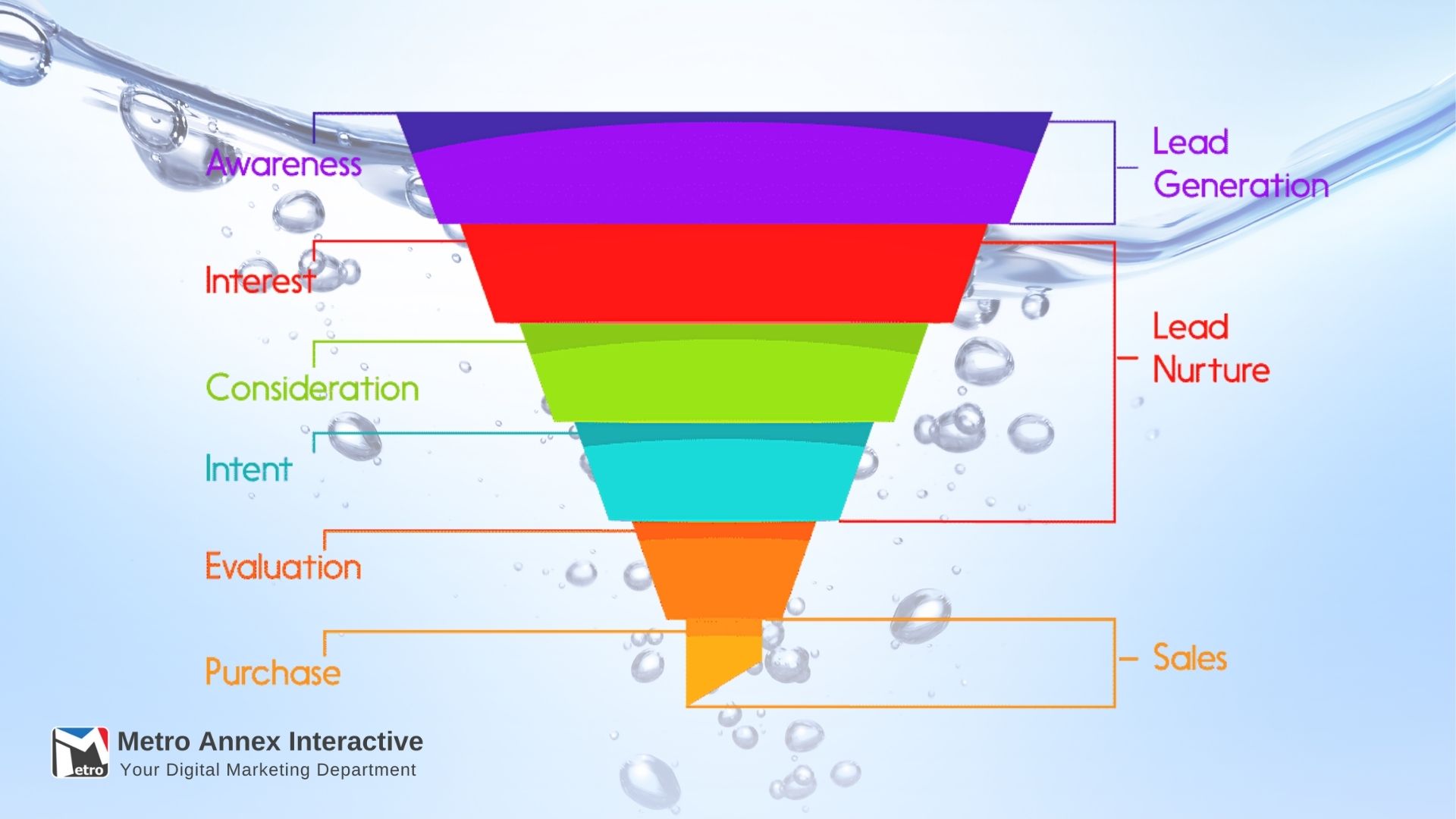Marketeering Blog
Why Your Business Needs a Marketing Funnel

Are you generating leads predictably and consistently?
A marketing funnel is a multi-step process of following a customer’s journey from visiting your website to buying your service or product. To help you track a lead and develop strategies to turn a prospect into a paying customer during that journey, your business needs a marketing funnel.

So, Just What is a Marketing Funnel?
Everyone knows what a funnel looks like: it’s wide at the top and narrows to a small opening. The top of the funnel captures what you are pouring into it. In this case, it’s a prospect; a person who showed interest in your service or product that you want to turn into a customer. The small opening at the end is the goal: the conversion (sale). In between the top and the end, it’s the journey a potential customer takes to what you hope is a purchase.
The reason the marketing funnel narrows is because at some point in the journey, the lead may drop out. Of course, you want to convert as many prospects as possible. The funnel helps you follow the potential customer and shows you the steps where you have opportunities to nurture and convince them to do business with you.
Lead Generation
Before we get into a deep dive of how a marketing funnel works, let’s talk about how to attract a prospect.
Lead generation is all about getting potential customers to visit your website. This is done by providing information about your product/service through various avenues like a blog, social media, advertising, referrals, webinar, video, or a promotion.
A great incentive to a prospect is a lead magnet; something of value you are offering for free that an interested person can download from a landing page on your website. A free consultation offer is also a great way to attract a lead.
By directing a prospect to a landing page, you can get their email address or other contact information when they fill out a form for the lead magnet. With the contact info in hand, you now have the opportunity to market your business to that prospect.
How Does a Marketing Funnel Work?
A marketing funnel is designed to drive visitors to your website and convert them to paying customers. The funnel has a series of stages to help marketers plan and measure efforts to attract, engage, and convert prospects through various marketing efforts as email, landing pages and ads. The funnel is custom made for each business – there is no one-size-fits-all!
The marketing funnel is made up of six parts:
1. Awareness – This is the first stage where customers learn about your business and have visited your website. Like a fisherman, you want to cast a wide net to gather as many prospects as possible. Make known your brand, product or service through various lead generation means as explained above. Use lead capture forms to get contact information, namely a prospect’s email address so you can market to them as they make their way through the rest of the funnel.
2. Interest – Once a prospect shows interest in your product or service by providing their contact info, they become a lead. It’s time to begin what is known as lead nurturing. This is where email marketing comes into play.
An email campaign is the most effective method. Send an email with information about your business to begin a direct relationship with the lead. You want to convince them that your product/service is their best solution.
3. Consideration – At this stage of the funnel, the lead is now a potential customer. They have zeroed in on a particular service/product and are considering making a purchase. This is where you step up your communication by sending an email with an incentive as to why they should buy from you and include a Call to Action (CTA).
4. Intent – The potential consumer is now close to clicking the “checkout” button. They may have contacted you with a few questions about the product or service. Perhaps they put something in their shopping cart and left it there. At this point, you now need to show them why your business is their best option. Retarget them with an ad or send another email – this one with a strong CTA – expressing urgency that they need to act now.
5. Evaluation – This is the stage before the conversion. The potential customer is making their final decision by evaluating the offer, price, and product/service. This is a marketer’s last chance to convince the consumer to buy. Once again, an email needs to be sent giving them a final nudge.
6. Purchase – You made a sale! The lead finished the journey through the entire funnel stages and came out at the end as a customer!
Follow-up
A sale shouldn’t be the end of it. You need to follow-up and add this customer to your database for future communications. Ask for referrals, a testimonial, or a review. Make this customer a returning customer!
Tracking Leads
You can follow the interest of prospects and leads by adding tracking code to blogs, emails, and social media. By reviewing open and click-through rates. you can adjust your marketing and communication. A CRM (Customer Relationship Management) database can help you track potential leads.
Why Do I Need Marketing Funnel?
Whether it’s B2C (Business to Customer) or B2B (Business to Business), your business needs a marketing funnel. The stages from capturing leads to purchase need to be followed so you or your marketing consultant knows when and how to target potential customers. The funnel lets you track leads through the process so you can customize communication efforts to educate, nurture, and convince a lead to become a paying customer.
Let the Professionals Help!
A marketing agency is your best bet to develop a marketing funnel for your business. You need to focus on your day-to-day operation, so let us do the marketing for you. Metro Annex Interactive has the time and experience to design strategies and plug any leaks that may develop in the funnel! Schedule a FREE Consultation to learn more.
Article Sources for Why Your Business Needs a Marketing Funnel
Feedough | Hotjar|Roseblade Media | Metro Insider Blog
#marketingfunnel #leadgeneration #leadtracking #MetroMarketeerArticle Resources
FREQUENTLY ASKED QUESTIONS
What is a marketing funnel?
A marketing funnel is a model that illustrates the journey a potential customer goes through, from first becoming aware of a business or product to making the final decision to purchase. It’s typically divided into stages, such as awareness, interest, decision, and action.
Why is a marketing funnel important for businesses?
A marketing funnel is important because it helps businesses understand and strategize the different stages a customer goes through before making a purchase. It allows for better targeting of marketing efforts, helps to identify bottlenecks in the sales process, and improves overall conversion rates by nurturing potential customers at each stage.
How do you create a marketing funnel?
To create a marketing funnel, first identify your target audience and their pain points. Then, map out the customer journey, from awareness to purchase. Create content and marketing strategies tailored to each stage of the funnel to guide prospects towards a decision. Lastly, use analytics to measure success and make continuous improvements.
Can marketing funnels be applied to all types of businesses?
Yes, marketing funnels can be applied to virtually all types of businesses, whether B2B or B2C, product- or service-based. However, the specifics of the funnel—such as the length, the marketing channels used, and the types of content—may vary depending on the business and industry.
What are the most common challenges with marketing funnels?
Common challenges with marketing funnels include creating engaging content that resonates with the target audience at different stages, effectively nurturing leads through the funnel, aligning sales and marketing efforts, and accurately measuring and attributing conversions.
How often should a marketing funnel be reviewed or updated?
A marketing funnel should be reviewed regularly, possibly quarterly or bi-annually, to ensure it aligns with current business goals, audience needs, and market conditions. It should also be updated whenever there is a significant change in your product offerings, target audience, or competition.

Mathew Phillips | Digital Marketing Specialist
Mathew Phillips is an expert in digital marketing and lead generation services. Mathew has a passion for all things digital marketing from website design and search engine optimization to digital advertising, email marketing and social media.
FREE 2024 DIGITAL MARKETING GUIDE
Stay Ahead of the Curve with Expert Insights and Monthly Marketing Tips
Boost Your Lead Generation
You’re one step closer to increasing your qualified leads.





